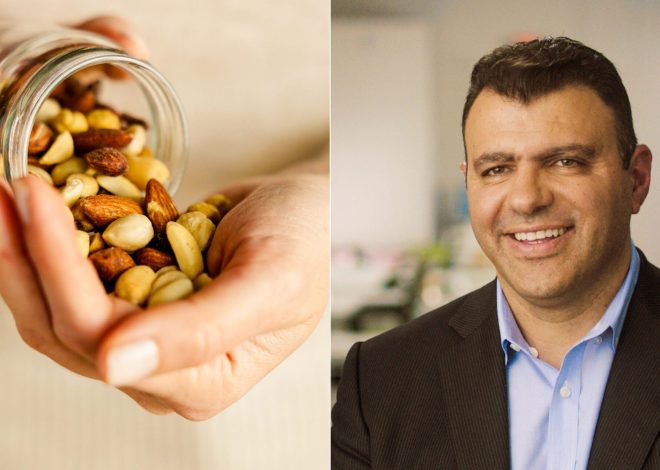
Heart expert advises two things
High cholesterol can lead to cardiovascular diseases such as heart attacks or strokes. Read how you can prevent them through proper nutrition and regular exercise.
Fulda – Cholesterol plays an important role in our hormone balance. Every cell in our body contains this natural substance. Our body can produce it itself. As hna.de reports, the right diet can keep cholesterol levels low and thus prevent cardiovascular diseases.
Reduce cholesterol levels effectively – expert recommends good fats and exercise
“Cholesterol is not a poison, but a vital substance, an elementary building block of all cells,” explains Professor Martin Halle, according to a press release from the German Society for the Control of Lipid Metabolism Disorders and their Secondary Diseases DGFF (Lipid League).
“Whether it’s the heart, brain or nerves – people cannot live without cholesterol,” explains Halle, medical director of the Chair and Polyclinic for Preventive and Rehabilitative Sports Medicine at the Medical Faculty of the Technical University of Munich.

Cholesterol is therefore essential for maintaining vital functions. However, it is important to keep an eye on cholesterol levels and prevent them from becoming too high. The cardiovascular disease expert expresses concerns about the modern lifestyle that promotes high cholesterol levels.
According to Martin Halle, risk factors include both a lack of exercise and a diet rich in unhealthy fats. Our body needs fats to produce cholesterol (blood fats). However, if too much cholesterol flows through our veins, the risk of it being deposited in the vessels and narrowing them increases.
A dangerous consequence of this development could be a heart attack or stroke, depending on the vessels affected. According to the DGFF, almost every second death in Germany is due to a disease of the cardiovascular system. High cholesterol is one of the most important risk factors, along with smoking, diabetes, high blood pressure and lack of exercise.
Abdominal obesity also has a very negative effect in this regard. But not all fats contribute to the narrowing of the blood vessels. “There are good and bad fats,” explains Martin Halle in an interview with the Focuss. The good fats are those that are liquid at room temperature, such as olive or rapeseed oil.
Which fats can lower cholesterol
But oils in nuts and pulses, cereals and whole grains also contain unsaturated fatty acids, which keep the blood vessel walls elastic. In contrast, saturated fatty acids are unhealthy fats. Examples of these are butter and coconut oil.
But other fats that are solid at room temperature should also be replaced by unsaturated fatty acids in order to lower cholesterol levels. “We can keep our entire body fit and active through our diet,” emphasizes specialist Martin Halle to the Focus.
He sees nutrition as an essential factor for the health of our cells. The experts differentiate between bad LDL cholesterol and good HDL cholesterol. The decisive factors for health, says the doctor, are a low proportion of “bad” LDL cholesterol, which promotes vascular deposits, and as high a proportion of the useful HDL cholesterol as possible.
If the LDL cholesterol content in the blood is permanently too high, cholesterol can be deposited in the blood vessel walls – so-called plaques are formed, warns the German Society for the Control of Lipid Metabolism Disorders and their Secondary Diseases. As a result, the blood vessels narrow over time – atherosclerosis (also known as “hardening of the arteries”) develops.
Everyone has the power to reduce their risk of cardiovascular disease.
“The plaques are initially soft, but can harden and burst” at some point. The result: a local thrombosis, i.e. a blockage of the affected blood vessels. These changes, the constriction and the blockage, lead, depending on where they occur, to circulatory problems in the legs, heart attacks or strokes. Ultimately, one can say: without a lot of cholesterol in the blood, there is no atherosclerosis.
The good HDL cholesterol can, so to speak, remove the bad LDL cholesterol and thus protect the blood vessels. Experts recommend an HDL cholesterol level of more than 40 mg/dl for men and more than 45 mg/dl for women. The cholesterol level is determined by a simple blood sample (fasting value). The DGFF advises adults to have their blood lipid levels checked.
Good and “bad” cholesterol in comparison
The experts point to the health-promoting aspect of sport. “You can increase your blood vessel-protecting HDL cholesterol by up to ten percent if you jog or cycle for 30 minutes a day,” says Professor Martin Halle. “Whether you’re 40 or 80, it’s never too late to start exercising. Everyone has the power to reduce their risk of cardiovascular disease.”
“While a lack of exercise leads to low HDL cholesterol, regular exercise improves the distribution of less favorable LDL and more favorable HDL cholesterol. Exercise also has a positive effect on blood pressure and insulin resistance. In addition, physical activity keeps the blood vessel walls elastic.”
Background: Bad LDL cholesterol, good HDL cholesterol
The word cholesterol comes from the Greek – chole (bile) and stereos (solid). Cholesterol – a fat-like, poorly water-soluble substance – is packed in protein packets in the body. Lipoproteins transport the cholesterol via the blood vessels to the body cells that need it. Lipoproteins are available with low density – low density lipoproteins (LDL) – and with high density – high density lipoproteins (HDL).
If the cholesterol supply is greater than the absorption capacity of the cell (or the infiltration does not work properly), the LDL and their cholesterol load remain in the blood. The LDL cholesterol level rises. The blood vessels constrict. In healthy adults without risk factors, the LDL level should be below 115 mg/dl (3.0 mmol/l). HDL, on the other hand, absorbs cholesterol and brings it back from the body’s cells to the liver, where it is metabolized. (sar)
According to Professor Martin Halle, endurance sports such as cycling, running or cross-country skiing are best suited to positively influencing blood lipid levels. The exercise should last at least 20 minutes, as this stimulates the enzymes that break down fats and thus lower triglycerides and increase HDL cholesterol. Shorter or very strenuous exercises, on the other hand, affect sugar metabolism rather than fat metabolism.”
The expert has another tip for anyone who wants to lower HDL – in relation to a low-fat diet. “With a low-fat diet, the bad LDL cholesterol drops, but the good HDL cholesterol also adjusts downwards. This is always surprising. You can counteract this drop by being physically active in addition to changing your diet. This way you can keep HDL at the original level.”

This article contains general information on the respective health topic and is therefore not intended for self-diagnosis, treatment or medication. It is in no way a substitute for a visit to the doctor. Unfortunately, our editors are not allowed to answer individual questions about medical conditions.

Ethel Purdy – Medical Blogger & Pharmacist
Bridging the world of wellness and science, Ethel Purdy is a professional voice in healthcare with a passion for sharing knowledge. At 36, she stands at the confluence of medical expertise and the written word, holding a pharmacy degree acquired under the rigorous education systems of Germany and Estonia.
Her pursuit of medicine was fueled by a desire to understand the intricacies of human health and to contribute to the community’s understanding of it. Transitioning seamlessly into the realm of blogging, Ethel has found a platform to demystify complex medical concepts for the everyday reader.
Ethel’s commitment to the world of medicine extends beyond her professional life into a personal commitment to health and wellness. Her hobbies reflect this dedication, often involving research on the latest medical advances, participating in wellness communities, and exploring the vast and varied dimensions of health.
Join Ethel as she distills her pharmaceutical knowledge into accessible wisdom, fostering an environment where science meets lifestyle and everyone is invited to learn. Whether you’re looking for insights into the latest health trends or trustworthy medical advice, Ethel’s blog is your gateway to the nexus of healthcare and daily living.



